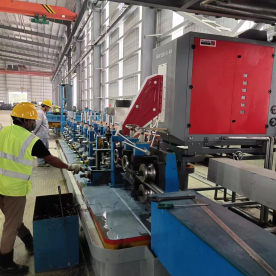****
In the diverse and constantly evolving landscape of manufacturing, achieving efficient heating solutions is crucial to ensure product quality and operational efficiency. One of the most innovative technologies in this space is industrial induction heating equipment. This technology has revolutionized how industries approach heating processes, offering unique benefits that traditional methods cannot match. In this article, we will examine the various applications, advantages, and future trends associated with industrial induction heating equipment.
Understanding Industrial Induction Heating

Exploring the Benefits and Applications of Industrial Induction Heating Equipment in Modern Manufacturing Processes
Induction heating is a process that utilizes electromagnetic fields to heat electrically conductive materials. It operates on the principle of electromagnetic induction, where an alternating magnetic field induces electric currents (also known as eddy currents) within conductive materials. This method generates heat internally, which makes it different from traditional heating methods that rely on external heat sources.
Industrial induction heating equipment typically comprises three main components: a power supply that generates high-frequency alternating current, an induction coil that creates the electromagnetic field, and the workpiece itself that undergoes heating. This equipment is used widely in several applications, including melting, forging, hardening, and soldering metals.
Key Benefits of Industrial Induction Heating Equipment
1. Energy Efficiency
One of the major advantages of induction heating is its energy efficiency. Induction heating typically achieves efficiencies of around 90% or more, compared to conventional heating methods, which may only reach efficiencies of 30% to 60%. The energy efficiency translates into lower operational costs, reduced heat loss, and a smaller carbon footprint, making it an environmentally friendly option.
2. Precision and Control
Industrial induction heating equipment offers precise temperature control, allowing manufacturers to heat materials to specific temperatures with minimal heat spread to surrounding areas. This level of control is especially crucial in processes like hardening and tempering, where exact temperatures are required to achieve desired material properties.
3. Speed
The rapid heating provided by induction heating enables shorter production cycles. Since materials can reach target temperatures almost instantly, this reduces overall processing time and increases throughput. For manufacturers, this means meeting customer demands more effectively and increasing competitiveness in the market.
4. Safety
Induction heating equipment operates at lower surface temperatures than conventional heating methods, reducing risks of burns and fire hazards. Moreover, the equipment can be equipped with various safety features, such as automatic shut-off mechanisms and temperature sensors, which enhance operational safety.
5. Versatility
Industrial induction heating can be applied to various metals and alloys, making it a versatile solution for multiple industries. Whether used for heating small components or large assemblies, induction heating is suitable for processes ranging from brazing and soldering to shrink fitting and surface hardening.
Applications of Industrial Induction Heating Equipment

Exploring the Benefits and Applications of Industrial Induction Heating Equipment in Modern Manufacturing Processes
The application of industrial induction heating is extensive across various sectors:
1. **Automotive**: Used for hardening gears and shafts, brazing joints, and preheating components for welding. 2. **Aerospace**: Employed for treating turbine blades and other critical components that require high precision and strength. 3. **Manufacturing**: Engaged in processes like die heating, forging, and induction melting of metals. 4. **Electronics**: Used for soldering circuit boards and joining components with precision. 5. **Jewelry Making**: Ideal for soldering and welding delicate pieces without damaging surrounding metal.
Future Trends
As industries continue to adopt Industry 4.0 principles, the future of industrial induction heating equipment looks promising. Advances in IoT integration, smart technology, and automated systems are expected to improve efficiency, monitoring, and maintenance, reducing downtime and further optimizing production processes.
Additionally, ongoing research continues to unlock new applications and improve existing technologies, making induction heating even more effective and adaptable to various industries’ needs.

Exploring the Benefits and Applications of Industrial Induction Heating Equipment in Modern Manufacturing Processes
Conclusion
Industrial induction heating equipment is an essential tool in modern manufacturing that provides numerous benefits, including energy efficiency, precision, safety, and versatility. As industries seek innovative solutions to enhance their production processes and meet evolving customer demands, the adoption of this technology will likely continue to grow. By understanding the advantages and applications of induction heating, businesses can leverage this powerful technology to remain competitive in an ever-changing industrial landscape.Mould for tube mill


